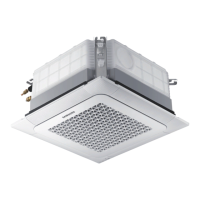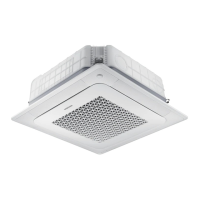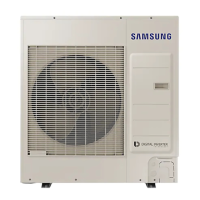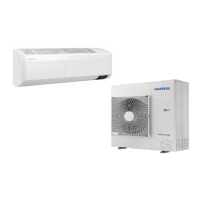12
Installation Procedure
English
Installation Procedure
CAUTION
• Be sure to wrap insulation tightly without any gaps.
3 Finish wrapping insulating tape around the rest of the
pipes leading to the outdoor unit.
4 The pipes and electrical cables connecting the indoor
unit with the outdoor unit must be fixed to the wall with
suitable ducts.
CAUTION
• Make sure that all refrigerant connection must be
accessible for easy maintenance and detachment.
• Install the insulation not to get wider and use the
adhesives on the connection part of it to prevent
moisture from entering.
• Wind the refrigerant pipe with insulation tape if it is
exposed to outside sunlight.
• Install the refrigerant pipe respecting that the insulation
does not get thinner on the bent part or hanger of pipe.
• Add the additional insulation if the insulation plate gets
thinner.
a x 3
Hanger
Additional insulation
a
Refrigerant pipe
insulation
5 Select the insulation of the refrigerant pipe.
• Insulate the gas side and liquid side pipe, noting the
insulation thickness that must differ according to the
pipe size.
• Standard: Less than an indoor temperature of 30°C,
with humidity at 85%. If installing in a high humidity
environment, use one grade thicker insulator by
referring to the table below. If installing in an
unfavourable environment, use thicker one.
• The heat-resistance temperature of the insulator must
be more than 120°C.
Pipe Pipe size
Insulation type
(heating/cooling)
Remarks
Standard
(Less than
30°C,
85%)
High
humidity
(Over 30°C,
85%)
EPDM, NBR
Liquid
pipe
Ø6.35 to
Ø9.52
9t 9t
The internal
temperature
is higher than
120°C.
Ø12.7 to
Ø19.05
13t 13t
Gas
pipe
Ø6.35 13t 19t
Ø9.52
19t 25t
Ø12.70
Ø15.88
Ø19.05
• When installing insulation in the places and
conditions below, use the same insulation that is used
for high humidity conditions.
<Geological condition>
High humidity locations such as shorelines, hot springs,
lake or riversides, and ridges (when part of the building is
covered by earth and sand)
<Operation purpose condition>
Restaurant ceiling, sauna, swimming pool etc.
<Building construction condition>
Ceilings frequently exposed to moisture and cooling are
not covered. For example, pipes installed at a corridor of a
dormitory and studio or near an exit that opens and closes
frequently.
Places (where the pipes are installed) that are highly humid
due to a lack of ventilation.

